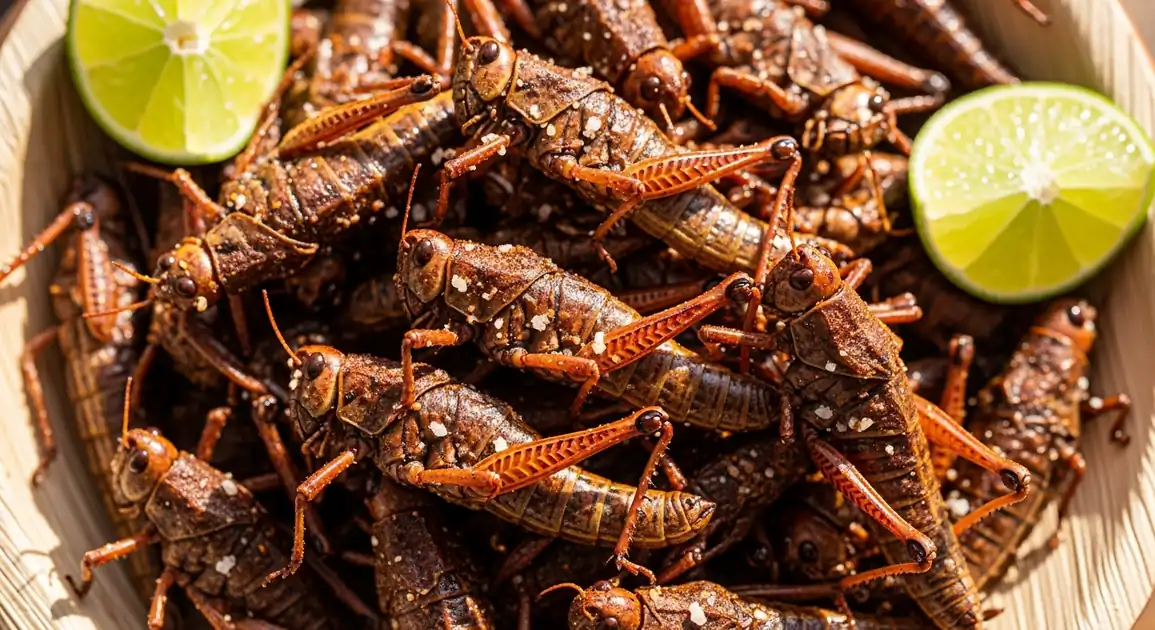Chapulines (Toasted Grasshoppers)
Chapulines

Description
Oaxaca is the spiritual home of chapulines, where this traditional insect food has been consumed since pre-Hispanic times. Here, they're not merely a novelty but a dietary staple and cultural symbol, prepared with generations of expertise. Oaxacan chapulines are renowned for their superior quality, flavor balance, and the skillful toasting techniques used by local vendors.
Dietary Information
Serving information
Serving style
In markets, typically sold in small plastic bags with lime wedges. In restaurants, served in small clay dishes, often as an appetizer. Commonly incorporated into traditional dishes like tlayudas, memelas, and tacos. Almost always accompanied by lime wedges.
Quick facts
Markets open early (7 AM - 8 PM), with freshest selection in mornings. Street vendors typically operate 10 AM - 8 PM. Restaurants and mezcalerías serve chapulines during normal business hours, typically until 10 PM - 12 AM.
Safety Tips
What to Look For
-
Uniform reddish-brown color
Properly toasted chapulines should have a consistent color without black (burnt) or pale (undercooked) specimens.
-
Completely dry and crispy texture
Chapulines must be thoroughly toasted to eliminate any pathogens and ensure food safety. They should snap when broken, not bend.
-
Clean, sorted product
Quality vendors carefully clean and sort their chapulines, removing debris, dirt, and extraneous parts.
-
Fresh, aromatic smell
Good chapulines have a pleasant aroma of lime, garlic, and chile. Avoid any that smell musty, rancid, or off.
-
Vendors with high turnover
Busy stalls typically have fresher product and maintain better quality control.
What to avoid
-
Damp or soft chapulines
Inadequately toasted chapulines may contain harmful bacteria. They should never feel moist or soft to the touch.
-
Black or very dark specimens
Burnt chapulines taste bitter and may contain harmful compounds from overcooking.
-
Chapulines with visible dirt or debris
Poor cleaning indicates substandard preparation practices that may impact food safety.
-
Stale or off-smelling product
Old or improperly stored chapulines can develop mold or rancidity. They should smell fresh and appetizing.
-
Exceptionally cheap prices
Quality chapulines require labor-intensive preparation. Suspiciously low prices may indicate shortcuts in cleaning or preparation.
Price information
Price range
Budget tips
- Markets like Central de Abastos offer the best prices (15-40 MXN for small portions).
- Prices vary by size - small chapulines are cheaper but more labor-intensive to prepare.
- Buying directly from producers at weekly markets (tianguis) often yields the best value.
- Tourist areas like around Zócalo charge premium prices (40-80 MXN for similar portions).
- Some restaurants charge 60-120 MXN when used as a featured ingredient in traditional dishes.
Value indicators
- Thorough cleaning without debris.
- Uniform toasting - consistently colored without burnt pieces.
- Proper seasoning with balanced flavors, not overly salty.
- Clear size grading - properly sorted chapulines indicate careful preparation.
- Fresh, aromatic smell with notes of lime, garlic, and mild chile.
Where to Find This Dish
Central de Abastos
Oaxaca's main market and the primary source for chapulines. Contains multiple specialized vendors with various sizes and preparations.
Dried goods section, Insect food vendors area
Early Morning (7 AM - 11 AM)
Mercado 20 de Noviembre
Food market with vendors selling chapulines and prepared dishes featuring them.
Dried foods section, Food stalls area
Morning to Afternoon (9 AM - 4 PM)
Around Zócalo (Main Square)
Tourist-oriented stands and shops selling chapulines, often in decorative packaging.
Streets surrounding the main square, Macedonio Alcalá pedestrian street
Afternoon to Evening (12 PM - 8 PM)
Mezcalerías in Centro Histórico
Bars specializing in mezcal typically serve quality chapulines as the traditional accompaniment.
Mezcal bars throughout downtown, Restaurant zone
Evening (6 PM - 11 PM)
Vendor Tips
- Look for vendors who clearly sort their chapulines by size - this indicates care in preparation.
- Ask vendors about their toasting method; traditional clay comal toasting is considered superior.
- The best vendors will happily explain their seasoning mix, often a family recipe.
- Quality vendors clean their chapulines meticulously - there should be no visible debris.
How to Order
Regional Variations
-
Size Grades
(Tamaños)
Oaxacan vendors meticulously sort chapulines by size: small (chicos), medium (medianos), and large (grandes), each with different culinary uses and prices.
-
Traditional Seasoning
(Sazonado Tradicional)
The classic Oaxacan preparation uses garlic, lime, salt, and mild chile, with some families adding a touch of agave worm salt (sal de gusano) or specific local herbs.
-
Chapulines for Tlayudas
(Chapulines para Tlayudas)
Specifically prepared smaller chapulines intended as a topping for Oaxaca's iconic large tortillas with assorted toppings.
-
Valley Variations
(Variaciones del Valle)
Slight preparation differences exist between the Central Valleys, the Mixteca region, and the Sierra Norte, with varying amounts of chile and herb additions.
Cultural context
History
Chapulines have been consumed in Mexico since pre-Hispanic times, with archaeological evidence dating back thousands of years. Indigenous peoples, particularly Zapotecs and Mixtecs in what is now Oaxaca, harvested these protein-rich insects as a sustainable food source. The Spanish conquest documented their culinary use in the 16th century. Traditional preparation methods have been passed down through generations, with each region developing particular seasoning preferences. While historically associated with rural and indigenous communities, chapulines have gained popularity nationally and internationally as interest in traditional Mexican cuisine and sustainable protein sources has grown.
Local significance
In Oaxaca, chapulines are a profound cultural symbol representing indigenous culinary traditions, sustainability, and regional identity. They're not considered exotic but rather an everyday food deeply connected to local heritage.
Eating customs
- Always served with lime wedges to squeeze fresh juice over them before eating.
- Often consumed as a protein-rich snack between meals.
- In traditional settings, eaten by hand directly from small clay dishes.
- Incorporated into countless local dishes, from simple street foods to complex moles.